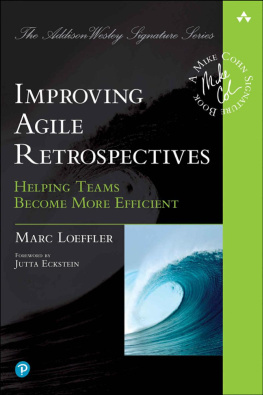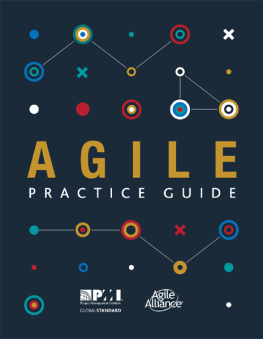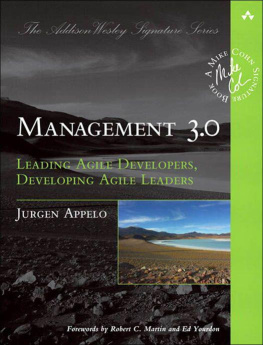About This E-Book
EPUB is an open, industry-standard format for e-books. However, support for EPUB and its many features varies across reading devices and applications. Use your device or app settings to customize the presentation to your liking. Settings that you can customize often include font, font size, single or double column, landscape or portrait mode, and figures that you can click or tap to enlarge. For additional information about the settings and features on your reading device or app, visit the device manufacturers Web site.
Many titles include programming code or configuration examples. To optimize the presentation of these elements, view the e-book in single-column, landscape mode and adjust the font size to the smallest setting. In addition to presenting code and configurations in the reflowable text format, we have included images of the code that mimic the presentation found in the print book; therefore, where the reflowable format may compromise the presentation of the code listing, you will see a Click here to view code image link. Click the link to view the print-fidelity code image. To return to the previous page viewed, click the Back button on your device or app.

Improving Agile Retrospectives
Helping Teams Become More Efficient
Marc Loeffler
Translated from German by Eamonn OLeary

Boston Columbus Indianapolis New York San Francisco Amsterdam Cape Town Dubai London Madrid Milan Munich Paris Montreal Toronto Delhi Mexico City So Paulo Sydney Hong Kong Seoul Singapore Taipei Tokyo
Editor-in-Chief: Mark Taub
Executive Editor: Chris Guzikowski
Development Editor: Chris Zahn
Managing Editor: Sandra Schroeder
Senior Project Editor: Lori Lyons
Copy Editor: Paula Lowell
Indexer: Erika Millen
Proofreader: H S Rupa
Editorial Assistant: Courtney Martin
Cover Designer: Chuti Prasertsith
Compositor: codeMantra
Many of the designations used by manufacturers and sellers to distinguish their products are claimed as trademarks. Where those designations appear in this book, and the publisher was aware of a trademark claim, the designations have been printed with initial capital letters or in all capitals.
The author and publisher have taken care in the preparation of this book, but make no expressed or implied warranty of any kind and assume no responsibility for errors or omissions. No liability is assumed for incidental or consequential damages in connection with or arising out of the use of the information or programs contained herein.
For information about buying this title in bulk quantities, or for special sales opportunities (which may include electronic versions; custom cover designs; and content particular to your business, training goals, marketing focus, or branding interests), please contact our corporate sales department at or (800) 382-3419.
For government sales inquiries, please contact .
For questions about sales outside the U.S., please contact .
Visit us on the Web: informit.com/aw
Library of Congress Control Number: 2017959642
Copyright 2018 Pearson Education, Inc.
All rights reserved. Printed in the United States of America. This publication is protected by copyright, and permission must be obtained from the publisher prior to any prohibited reproduction, storage in a retrieval system, or transmission in any form or by any means, electronic, mechanical, photocopying, recording, or likewise. For information regarding permissions, request forms, and the appropriate contacts within the Pearson Education Global Rights & Permissions Department, please visit www.pearsoned.com/permissions/.
ISBN-13: 978-0-13-467834-4
ISBN-10: 0-13-467834-6
1 17
To mom and dad.
Contents at a Glance
Contents
Reader Services
Register your copy of Improving Agile Retrospectives on the InformIT site for convenient access to updates and corrections as they become available. To start the registration process, go to informit.com/register and log in or create an account. Enter the product ISBN 9780134678344 and click Submit. Look on the Registered Products tab for an Access Bonus Content link next to this product, and follow that link to access any available bonus materials. If you would like to be notified of exclusive offers on new editions and updates, please check the box to receive email from us.
Please visit www.improvingagileretrospectives.com to download accompanying information to the book.
Foreword by Jutta Eckstein
I recently read the following story in a daily newspaper. In a hotel in Amman, Jordan, a businessman is waiting in front of an elevator. It is one of those big, lavish hotels, which has, in order to better meet the demands of its guests, placed six elevators next to one another. This businessman waits and waits, but the elevator doesnt come. The problem is that he is standing so close to the elevator that he fails to notice that some of the other elevators have been at his floor for a long time. Were he to take two paces backward, he would reach his goal more quickly.
This story illustrates how we humans tend to cling to an established decision or a previous experience (the elevator we have called will come and not another one). We then blindly follow the old, familiar pathweve always done it this way or thats how its always beeninstead of subjecting it to a critical assessment.
The fundamental idea of retrospectives is to pause, consider the chosen path and, in order to make better progress in the future, to correct that path by means of a (usually small) change. Actually, this approach is rooted in our DNA: the correct Latin term for the human race is not, as is commonly believed, Homo Sapiens, but Homo Sapiens Sapiensthat is, the human who thinks about thinking (or also, the human who thinks twice). It is exactly this reflection on our normal, everyday experiences that stands at the center of retrospectives.
It is often the case in projects or companies that individual team members are well aware of how things might be improved. However, it also often the case that there is insufficient time to examine the possible changes in detail. So nothing is changed, and the result is usually that the team has even less time. This situation is a vicious cycle and is aptly expressed with the old complaint: We dont have time to sharpen the saws, we have to saw.
Retrospectives should thus also be considered part of risk management; the constant analysis of events and ensuing course corrections mean that risks can be more quickly recognized and managed. Despite the fact that retrospectives have been principally used in agile software development in order to ensure agility, the regular implementation of retrospectives can be valuable in other areas. The reason for this is partly that, as another old saying goes, you learn through mistakes. However, many companies consider making mistakes a mistake and demand instead that you do it right the first time. But in our increasingly complex world, finding out what needs to change is not just the larger part of software development. In other areas, too, the first step is to explore which is the best path to the goal. In order to do that, you must also go down some wrong paths.; otherwise, you cannot know which are the right ones.
The right decisions can thus only be reached through the development of the systemand so you may well ask: why continue with this approach? Simply put, exploration is an inherent component of software development and, in todays world, many other areas.










